4UDBE Level 4 Dynamic Business Environments Open-book Exam Solution
VerifiedAdded on 2021/05/21
|19
|5317
|541
Homework Assignment
AI Summary
This document presents a comprehensive solution to the 4UDBE Level 4 Dynamic Business Environments open-book exam, focusing on two key questions. The first question compares different economic systems (command, market, and mixed economies), providing examples to illustrate their advantages and disadvantages. The second question delves into how analyzing the external environment, using tools like PESTLE analysis, enables organizations to develop successful business strategies, with a specific focus on Fibre Tech Industrial Plastics (FTIP). The solution analyzes the political, economic, social, technological, legal, and environmental factors influencing FTIP's operations and offers insights into how the company can adapt its strategies to thrive in its business environment. The assignment includes detailed answers, supporting evidence, and is structured to meet the requirements of the exam, including word count and referencing.
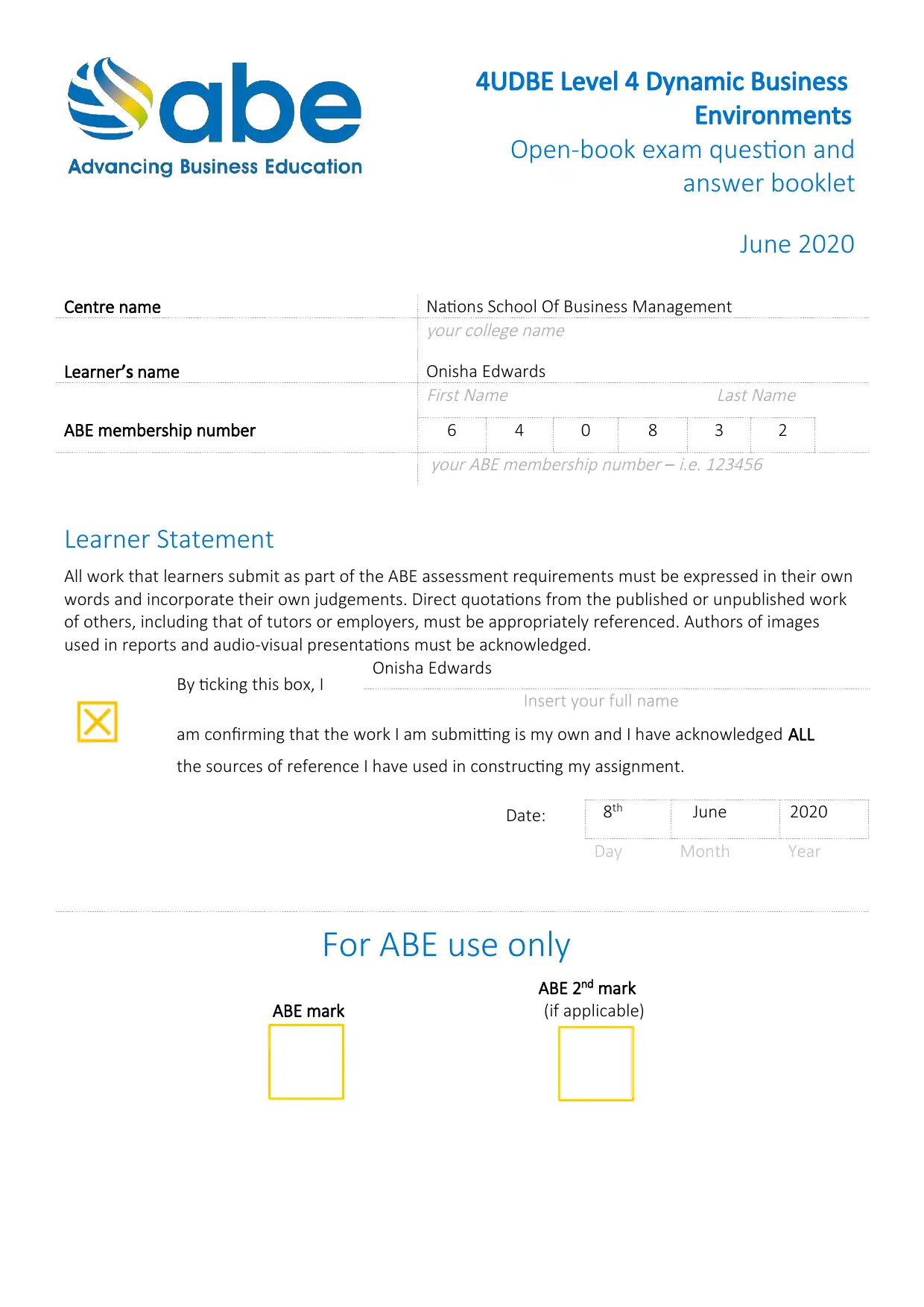
June 2020
Centre name Nations School Of Business Management
your college name
Learner’s name Onisha Edwards
First Name
Last Name
ABE membership number 6 4 0 8 3 2
your ABE membership number –
i.e. 123456
Learner Statement
All work that learners submit as part of the ABE assessment requirements must be expressed in their own
words and incorporate their own judgements. Direct quotations from the published or unpublished work
of others, including that of tutors or employers, must be appropriately referenced. Authors of images
used in reports and audio-visual presentations must be acknowledged.
☒ By ticking this box, I Onisha Edwards
Insert your full name
am confirming that the work I am submitting is my own and I have acknowledged ALL
the sources of reference I have used in constructing my assignment.
Date: 8th June 2020
Day Month Year
For ABE use only
ABE 2nd mark
ABE mark (if applicable)
4UDBE Level 4 Dynamic Business
Environments
Open-book exam question and
answer booklet
Centre name Nations School Of Business Management
your college name
Learner’s name Onisha Edwards
First Name
Last Name
ABE membership number 6 4 0 8 3 2
your ABE membership number –
i.e. 123456
Learner Statement
All work that learners submit as part of the ABE assessment requirements must be expressed in their own
words and incorporate their own judgements. Direct quotations from the published or unpublished work
of others, including that of tutors or employers, must be appropriately referenced. Authors of images
used in reports and audio-visual presentations must be acknowledged.
☒ By ticking this box, I Onisha Edwards
Insert your full name
am confirming that the work I am submitting is my own and I have acknowledged ALL
the sources of reference I have used in constructing my assignment.
Date: 8th June 2020
Day Month Year
For ABE use only
ABE 2nd mark
ABE mark (if applicable)
4UDBE Level 4 Dynamic Business
Environments
Open-book exam question and
answer booklet
Paraphrase This Document
Need a fresh take? Get an instant paraphrase of this document with our AI Paraphraser
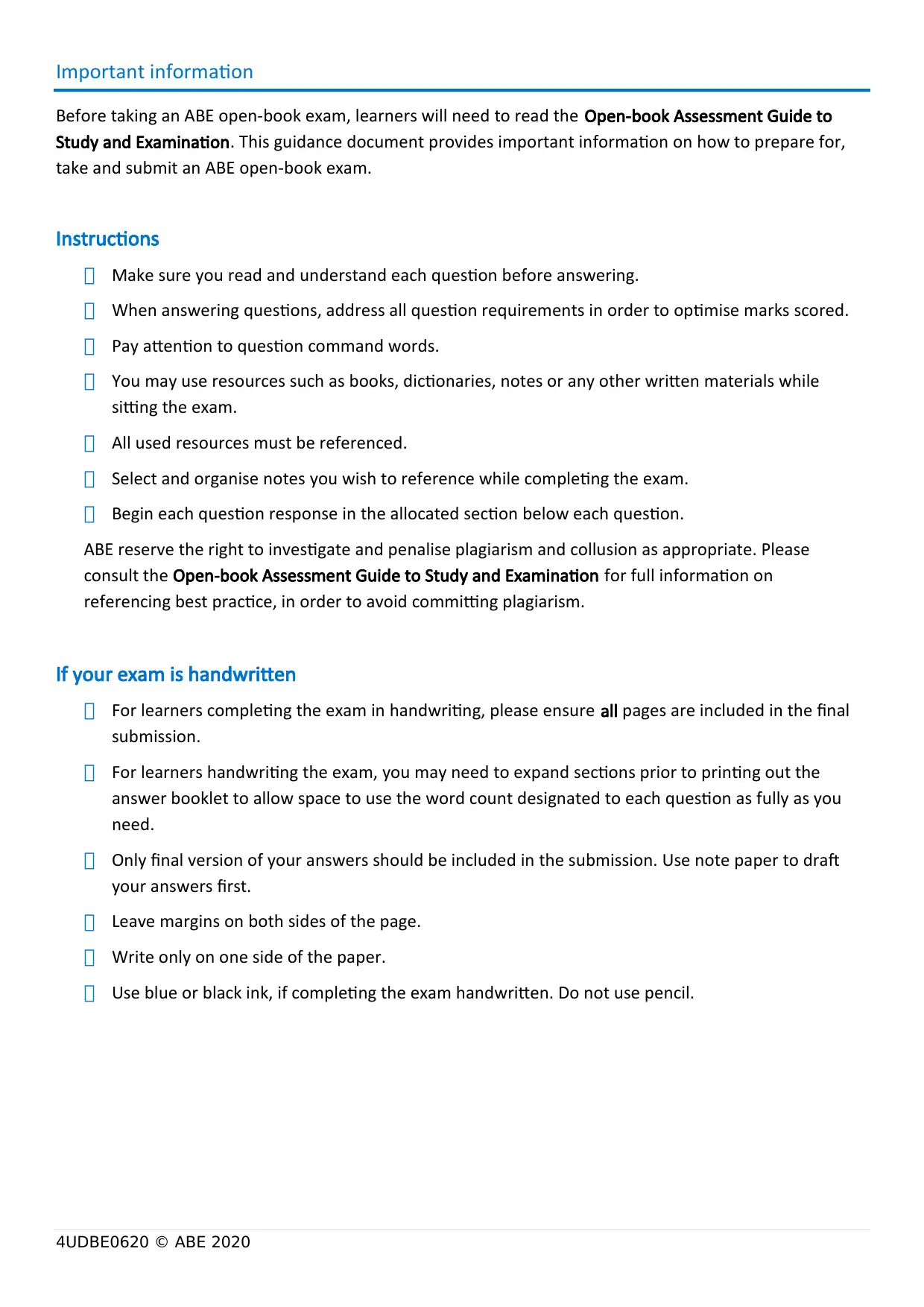
4UDBE0620 © ABE 2020
Important information
Before taking an ABE open-book exam, learners will need to read the Open-book Assessment Guide to
Study and Examination. This guidance document provides important information on how to prepare for,
take and submit an ABE open-book exam.
Instructions
Make sure you read and understand each question before answering.
When answering questions, address all question requirements in order to optimise marks scored.
Pay attention to question command words.
You may use resources such as books, dictionaries, notes or any other written materials while
sitting the exam.
All used resources must be referenced.
Select and organise notes you wish to reference while completing the exam.
Begin each question response in the allocated section below each question.
ABE reserve the right to investigate and penalise plagiarism and collusion as appropriate. Please
consult the Open-book Assessment Guide to Study and Examination for full information on
referencing best practice, in order to avoid committing plagiarism.
If your exam is handwritten
For learners completing the exam in handwriting, please ensure all pages are included in the final
submission.
For learners handwriting the exam, you may need to expand sections prior to printing out the
answer booklet to allow space to use the word count designated to each question as fully as you
need.
Only final version of your answers should be included in the submission. Use note paper to draft
your answers first.
Leave margins on both sides of the page.
Write only on one side of the paper.
Use blue or black ink, if completing the exam handwritten. Do not use pencil.
Important information
Before taking an ABE open-book exam, learners will need to read the Open-book Assessment Guide to
Study and Examination. This guidance document provides important information on how to prepare for,
take and submit an ABE open-book exam.
Instructions
Make sure you read and understand each question before answering.
When answering questions, address all question requirements in order to optimise marks scored.
Pay attention to question command words.
You may use resources such as books, dictionaries, notes or any other written materials while
sitting the exam.
All used resources must be referenced.
Select and organise notes you wish to reference while completing the exam.
Begin each question response in the allocated section below each question.
ABE reserve the right to investigate and penalise plagiarism and collusion as appropriate. Please
consult the Open-book Assessment Guide to Study and Examination for full information on
referencing best practice, in order to avoid committing plagiarism.
If your exam is handwritten
For learners completing the exam in handwriting, please ensure all pages are included in the final
submission.
For learners handwriting the exam, you may need to expand sections prior to printing out the
answer booklet to allow space to use the word count designated to each question as fully as you
need.
Only final version of your answers should be included in the submission. Use note paper to draft
your answers first.
Leave margins on both sides of the page.
Write only on one side of the paper.
Use blue or black ink, if completing the exam handwritten. Do not use pencil.
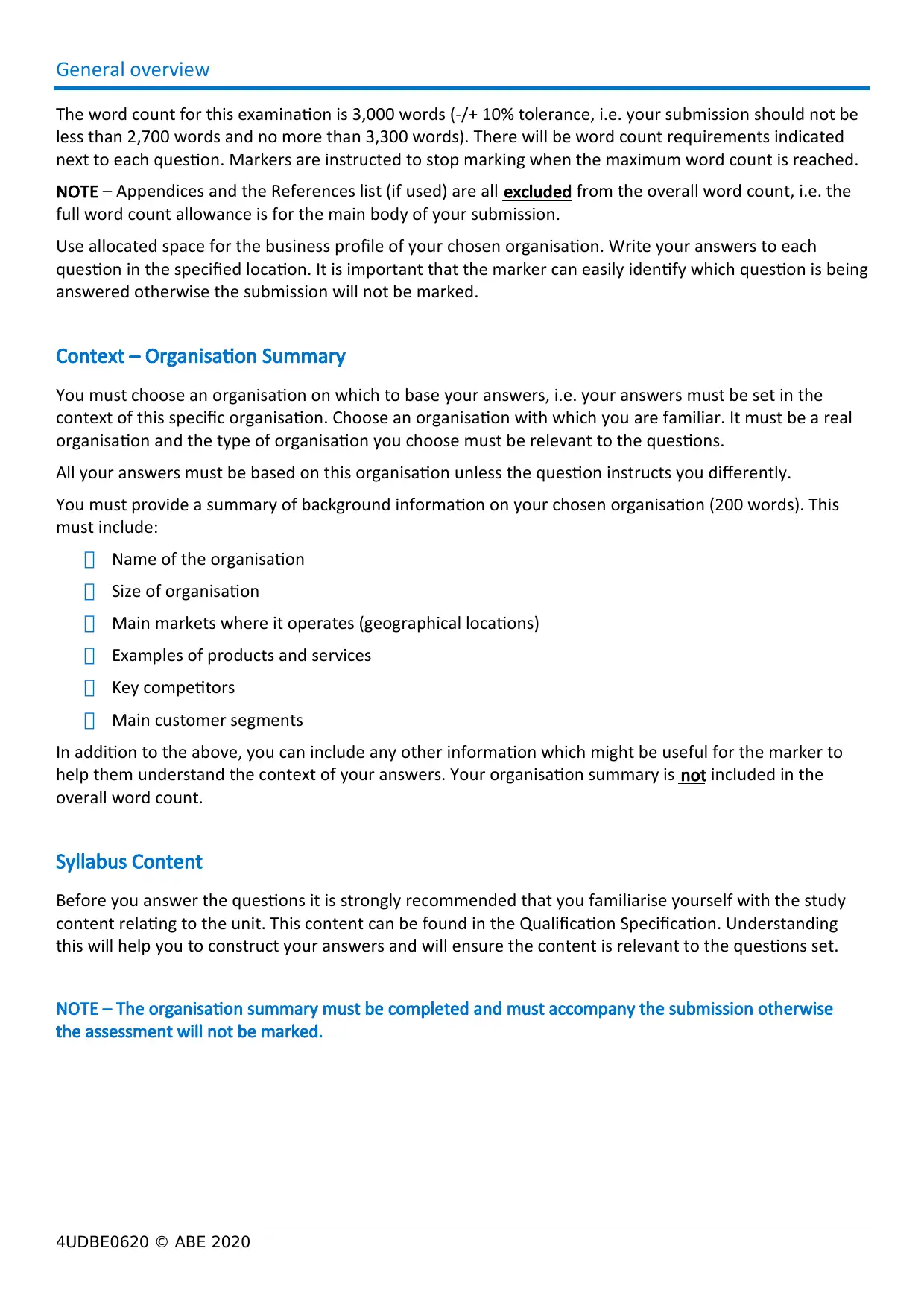
4UDBE0620 © ABE 2020
General overview
The word count for this examination is 3,000 words (-/+ 10% tolerance, i.e. your submission should not be
less than 2,700 words and no more than 3,300 words). There will be word count requirements indicated
next to each question. Markers are instructed to stop marking when the maximum word count is reached.
NOTE – Appendices and the References list (if used) are all excluded from the overall word count, i.e. the
full word count allowance is for the main body of your submission.
Use allocated space for the business profile of your chosen organisation. Write your answers to each
question in the specified location. It is important that the marker can easily identify which question is being
answered otherwise the submission will not be marked.
Context – Organisation Summary
You must choose an organisation on which to base your answers, i.e. your answers must be set in the
context of this specific organisation. Choose an organisation with which you are familiar. It must be a real
organisation and the type of organisation you choose must be relevant to the questions.
All your answers must be based on this organisation unless the question instructs you differently.
You must provide a summary of background information on your chosen organisation (200 words). This
must include:
Name of the organisation
Size of organisation
Main markets where it operates (geographical locations)
Examples of products and services
Key competitors
Main customer segments
In addition to the above, you can include any other information which might be useful for the marker to
help them understand the context of your answers. Your organisation summary is not included in the
overall word count.
Syllabus Content
Before you answer the questions it is strongly recommended that you familiarise yourself with the study
content relating to the unit. This content can be found in the Qualification Specification. Understanding
this will help you to construct your answers and will ensure the content is relevant to the questions set.
NOTE – The organisation summary must be completed and must accompany the submission otherwise
the assessment will not be marked.
General overview
The word count for this examination is 3,000 words (-/+ 10% tolerance, i.e. your submission should not be
less than 2,700 words and no more than 3,300 words). There will be word count requirements indicated
next to each question. Markers are instructed to stop marking when the maximum word count is reached.
NOTE – Appendices and the References list (if used) are all excluded from the overall word count, i.e. the
full word count allowance is for the main body of your submission.
Use allocated space for the business profile of your chosen organisation. Write your answers to each
question in the specified location. It is important that the marker can easily identify which question is being
answered otherwise the submission will not be marked.
Context – Organisation Summary
You must choose an organisation on which to base your answers, i.e. your answers must be set in the
context of this specific organisation. Choose an organisation with which you are familiar. It must be a real
organisation and the type of organisation you choose must be relevant to the questions.
All your answers must be based on this organisation unless the question instructs you differently.
You must provide a summary of background information on your chosen organisation (200 words). This
must include:
Name of the organisation
Size of organisation
Main markets where it operates (geographical locations)
Examples of products and services
Key competitors
Main customer segments
In addition to the above, you can include any other information which might be useful for the marker to
help them understand the context of your answers. Your organisation summary is not included in the
overall word count.
Syllabus Content
Before you answer the questions it is strongly recommended that you familiarise yourself with the study
content relating to the unit. This content can be found in the Qualification Specification. Understanding
this will help you to construct your answers and will ensure the content is relevant to the questions set.
NOTE – The organisation summary must be completed and must accompany the submission otherwise
the assessment will not be marked.
⊘ This is a preview!⊘
Do you want full access?
Subscribe today to unlock all pages.

Trusted by 1+ million students worldwide
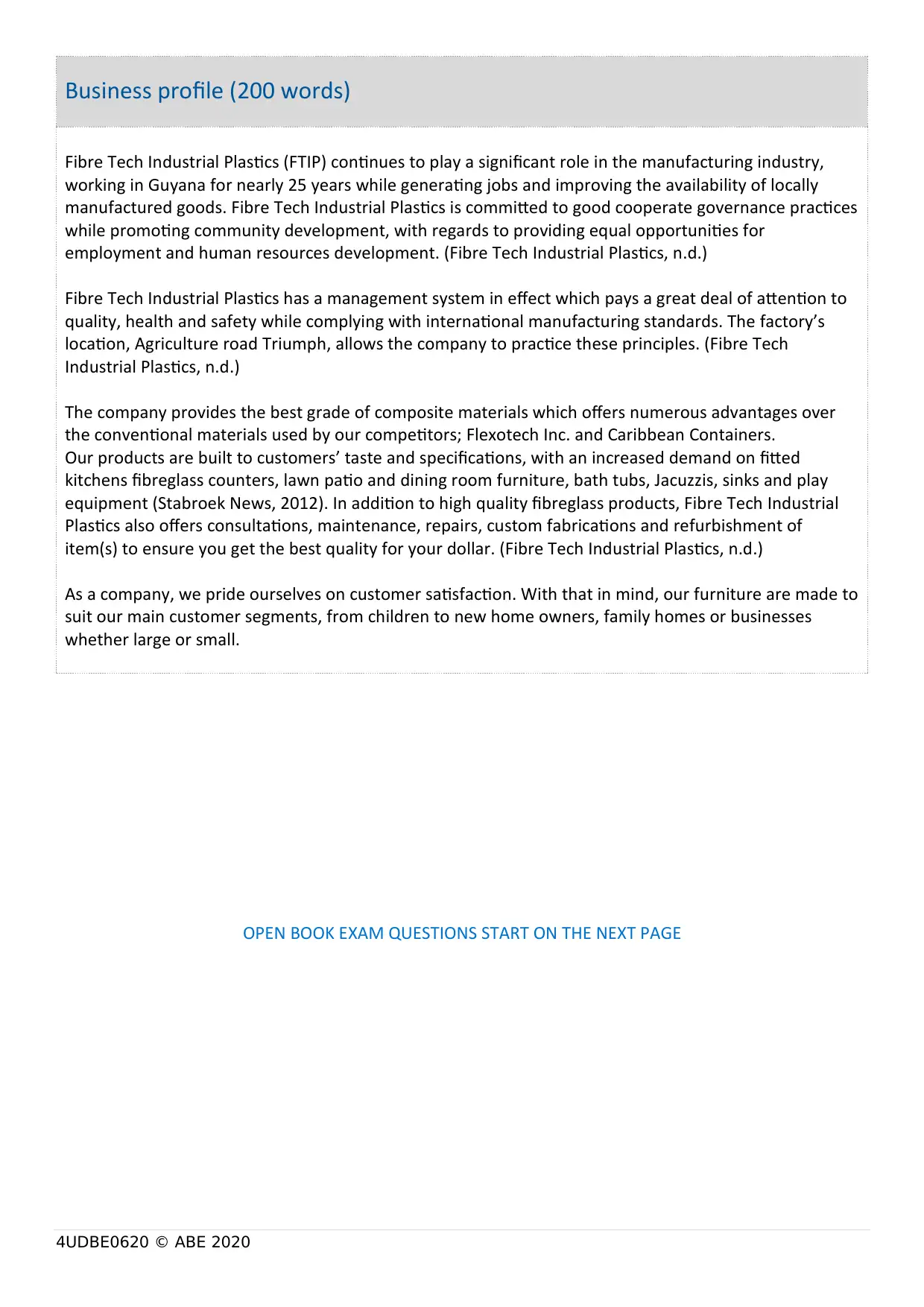
4UDBE0620 © ABE 2020
Business profile (200 words)
Fibre Tech Industrial Plastics (FTIP) continues to play a significant role in the manufacturing industry,
working in Guyana for nearly 25 years while generating jobs and improving the availability of locally
manufactured goods. Fibre Tech Industrial Plastics is committed to good cooperate governance practices
while promoting community development, with regards to providing equal opportunities for
employment and human resources development. (Fibre Tech Industrial Plastics, n.d.)
Fibre Tech Industrial Plastics has a management system in effect which pays a great deal of attention to
quality, health and safety while complying with international manufacturing standards. The factory’s
location, Agriculture road Triumph, allows the company to practice these principles. (Fibre Tech
Industrial Plastics, n.d.)
The company provides the best grade of composite materials which offers numerous advantages over
the conventional materials used by our competitors; Flexotech Inc. and Caribbean Containers.
Our products are built to customers’ taste and specifications, with an increased demand on fitted
kitchens fibreglass counters, lawn patio and dining room furniture, bath tubs, Jacuzzis, sinks and play
equipment (Stabroek News, 2012). In addition to high quality fibreglass products, Fibre Tech Industrial
Plastics also offers consultations, maintenance, repairs, custom fabrications and refurbishment of
item(s) to ensure you get the best quality for your dollar. (Fibre Tech Industrial Plastics, n.d.)
As a company, we pride ourselves on customer satisfaction. With that in mind, our furniture are made to
suit our main customer segments, from children to new home owners, family homes or businesses
whether large or small.
OPEN BOOK EXAM QUESTIONS START ON THE NEXT PAGE
Business profile (200 words)
Fibre Tech Industrial Plastics (FTIP) continues to play a significant role in the manufacturing industry,
working in Guyana for nearly 25 years while generating jobs and improving the availability of locally
manufactured goods. Fibre Tech Industrial Plastics is committed to good cooperate governance practices
while promoting community development, with regards to providing equal opportunities for
employment and human resources development. (Fibre Tech Industrial Plastics, n.d.)
Fibre Tech Industrial Plastics has a management system in effect which pays a great deal of attention to
quality, health and safety while complying with international manufacturing standards. The factory’s
location, Agriculture road Triumph, allows the company to practice these principles. (Fibre Tech
Industrial Plastics, n.d.)
The company provides the best grade of composite materials which offers numerous advantages over
the conventional materials used by our competitors; Flexotech Inc. and Caribbean Containers.
Our products are built to customers’ taste and specifications, with an increased demand on fitted
kitchens fibreglass counters, lawn patio and dining room furniture, bath tubs, Jacuzzis, sinks and play
equipment (Stabroek News, 2012). In addition to high quality fibreglass products, Fibre Tech Industrial
Plastics also offers consultations, maintenance, repairs, custom fabrications and refurbishment of
item(s) to ensure you get the best quality for your dollar. (Fibre Tech Industrial Plastics, n.d.)
As a company, we pride ourselves on customer satisfaction. With that in mind, our furniture are made to
suit our main customer segments, from children to new home owners, family homes or businesses
whether large or small.
OPEN BOOK EXAM QUESTIONS START ON THE NEXT PAGE
Paraphrase This Document
Need a fresh take? Get an instant paraphrase of this document with our AI Paraphraser
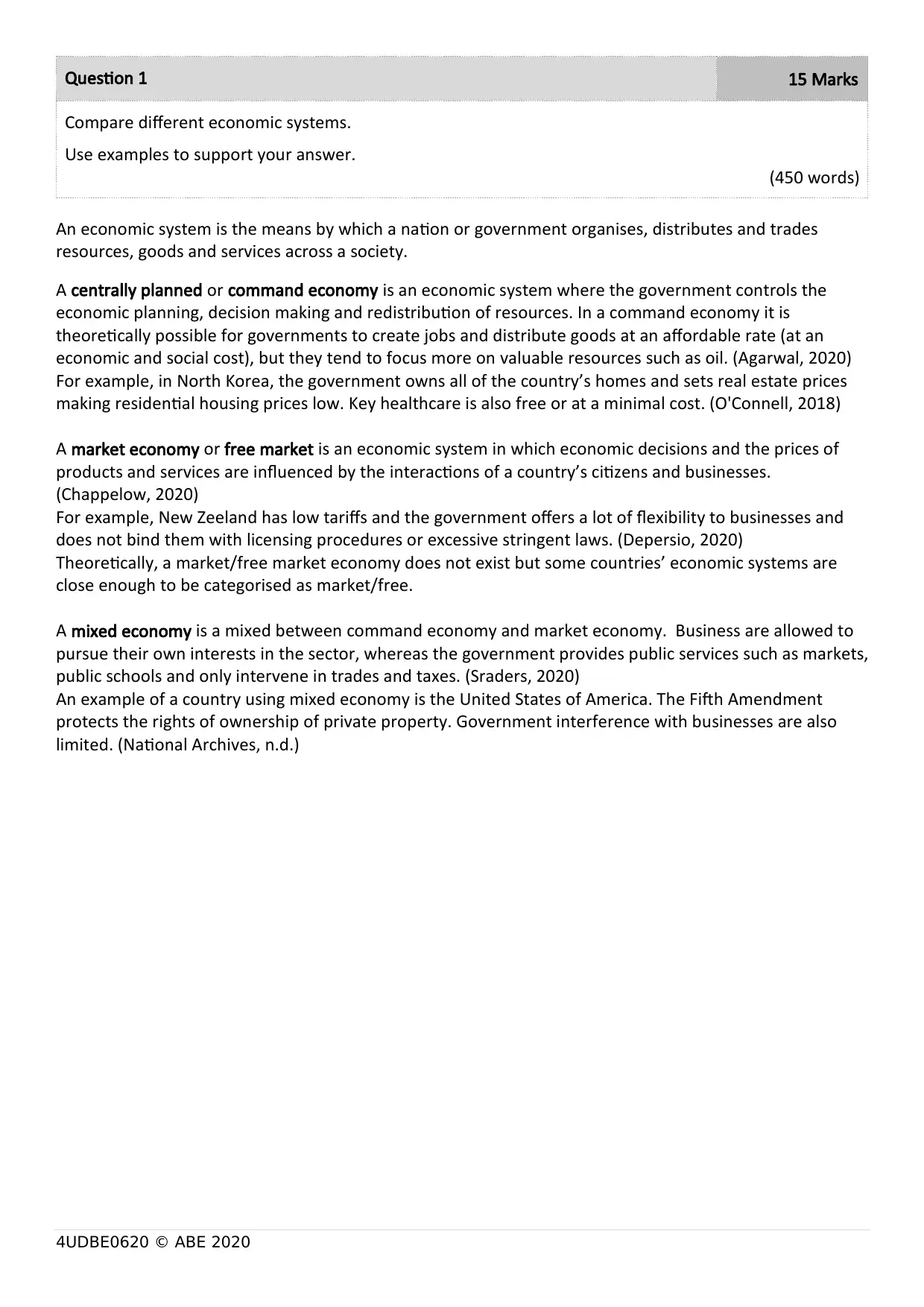
4UDBE0620 © ABE 2020
Question 1 15 Marks
Compare different economic systems.
Use examples to support your answer.
(450 words)
An economic system is the means by which a nation or government organises, distributes and trades
resources, goods and services across a society.
A centrally planned or command economy is an economic system where the government controls the
economic planning, decision making and redistribution of resources. In a command economy it is
theoretically possible for governments to create jobs and distribute goods at an affordable rate (at an
economic and social cost), but they tend to focus more on valuable resources such as oil. (Agarwal, 2020)
For example, in North Korea, the government owns all of the country’s homes and sets real estate prices
making residential housing prices low. Key healthcare is also free or at a minimal cost. (O'Connell, 2018)
A market economy or free market is an economic system in which economic decisions and the prices of
products and services are influenced by the interactions of a country’s citizens and businesses.
(Chappelow, 2020)
For example, New Zeeland has low tariffs and the government offers a lot of flexibility to businesses and
does not bind them with licensing procedures or excessive stringent laws. (Depersio, 2020)
Theoretically, a market/free market economy does not exist but some countries’ economic systems are
close enough to be categorised as market/free.
A mixed economy is a mixed between command economy and market economy. Business are allowed to
pursue their own interests in the sector, whereas the government provides public services such as markets,
public schools and only intervene in trades and taxes. (Sraders, 2020)
An example of a country using mixed economy is the United States of America. The Fifth Amendment
protects the rights of ownership of private property. Government interference with businesses are also
limited. (National Archives, n.d.)
Question 1 15 Marks
Compare different economic systems.
Use examples to support your answer.
(450 words)
An economic system is the means by which a nation or government organises, distributes and trades
resources, goods and services across a society.
A centrally planned or command economy is an economic system where the government controls the
economic planning, decision making and redistribution of resources. In a command economy it is
theoretically possible for governments to create jobs and distribute goods at an affordable rate (at an
economic and social cost), but they tend to focus more on valuable resources such as oil. (Agarwal, 2020)
For example, in North Korea, the government owns all of the country’s homes and sets real estate prices
making residential housing prices low. Key healthcare is also free or at a minimal cost. (O'Connell, 2018)
A market economy or free market is an economic system in which economic decisions and the prices of
products and services are influenced by the interactions of a country’s citizens and businesses.
(Chappelow, 2020)
For example, New Zeeland has low tariffs and the government offers a lot of flexibility to businesses and
does not bind them with licensing procedures or excessive stringent laws. (Depersio, 2020)
Theoretically, a market/free market economy does not exist but some countries’ economic systems are
close enough to be categorised as market/free.
A mixed economy is a mixed between command economy and market economy. Business are allowed to
pursue their own interests in the sector, whereas the government provides public services such as markets,
public schools and only intervene in trades and taxes. (Sraders, 2020)
An example of a country using mixed economy is the United States of America. The Fifth Amendment
protects the rights of ownership of private property. Government interference with businesses are also
limited. (National Archives, n.d.)
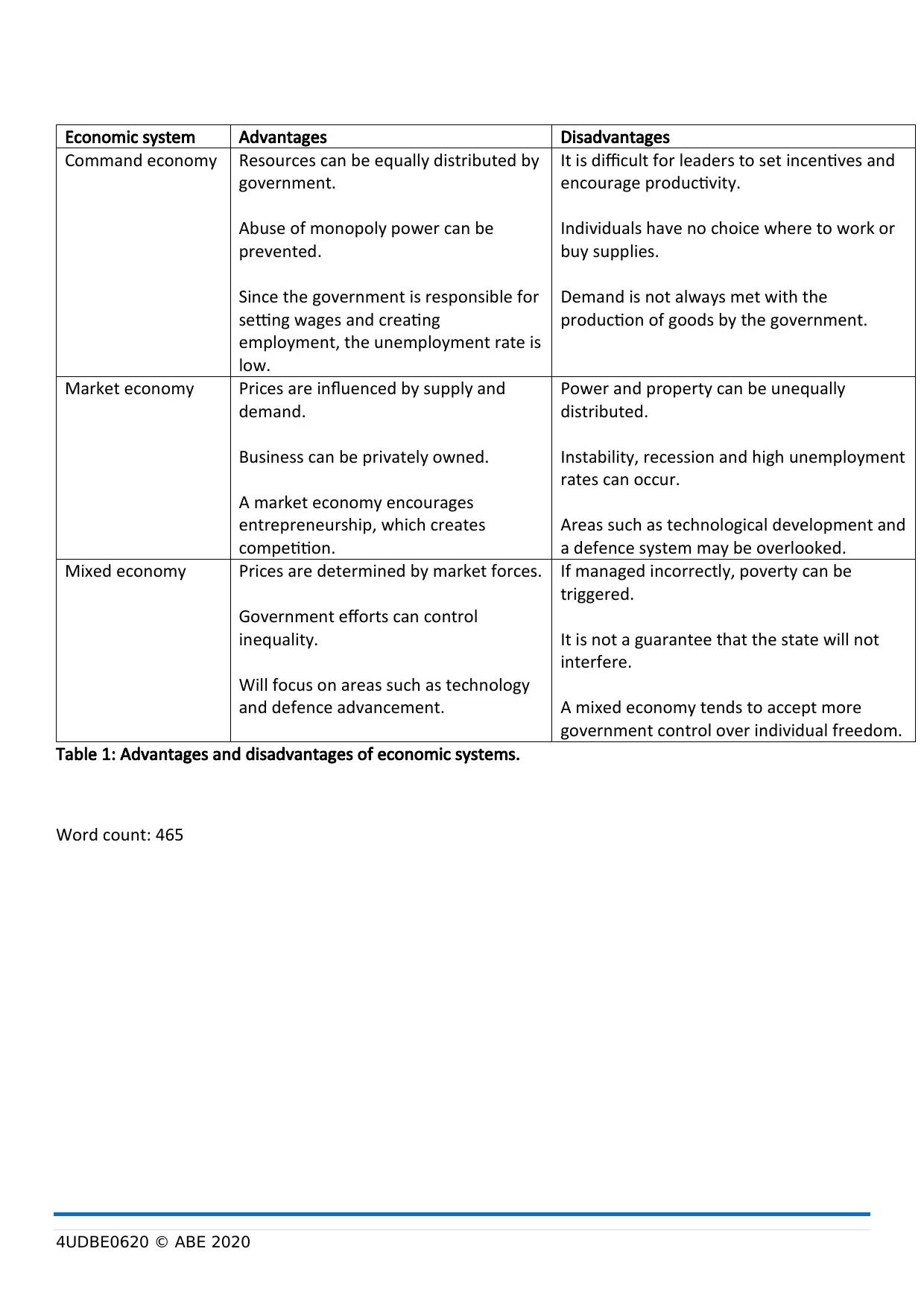
4UDBE0620 © ABE 2020
Economic system Advantages Disadvantages
Command economy Resources can be equally distributed by
government.
Abuse of monopoly power can be
prevented.
Since the government is responsible for
setting wages and creating
employment, the unemployment rate is
low.
It is difficult for leaders to set incentives and
encourage productivity.
Individuals have no choice where to work or
buy supplies.
Demand is not always met with the
production of goods by the government.
Market economy Prices are influenced by supply and
demand.
Business can be privately owned.
A market economy encourages
entrepreneurship, which creates
competition.
Power and property can be unequally
distributed.
Instability, recession and high unemployment
rates can occur.
Areas such as technological development and
a defence system may be overlooked.
Mixed economy Prices are determined by market forces.
Government efforts can control
inequality.
Will focus on areas such as technology
and defence advancement.
If managed incorrectly, poverty can be
triggered.
It is not a guarantee that the state will not
interfere.
A mixed economy tends to accept more
government control over individual freedom.
Table 1: Advantages and disadvantages of economic systems.
Word count: 465
Economic system Advantages Disadvantages
Command economy Resources can be equally distributed by
government.
Abuse of monopoly power can be
prevented.
Since the government is responsible for
setting wages and creating
employment, the unemployment rate is
low.
It is difficult for leaders to set incentives and
encourage productivity.
Individuals have no choice where to work or
buy supplies.
Demand is not always met with the
production of goods by the government.
Market economy Prices are influenced by supply and
demand.
Business can be privately owned.
A market economy encourages
entrepreneurship, which creates
competition.
Power and property can be unequally
distributed.
Instability, recession and high unemployment
rates can occur.
Areas such as technological development and
a defence system may be overlooked.
Mixed economy Prices are determined by market forces.
Government efforts can control
inequality.
Will focus on areas such as technology
and defence advancement.
If managed incorrectly, poverty can be
triggered.
It is not a guarantee that the state will not
interfere.
A mixed economy tends to accept more
government control over individual freedom.
Table 1: Advantages and disadvantages of economic systems.
Word count: 465
⊘ This is a preview!⊘
Do you want full access?
Subscribe today to unlock all pages.

Trusted by 1+ million students worldwide
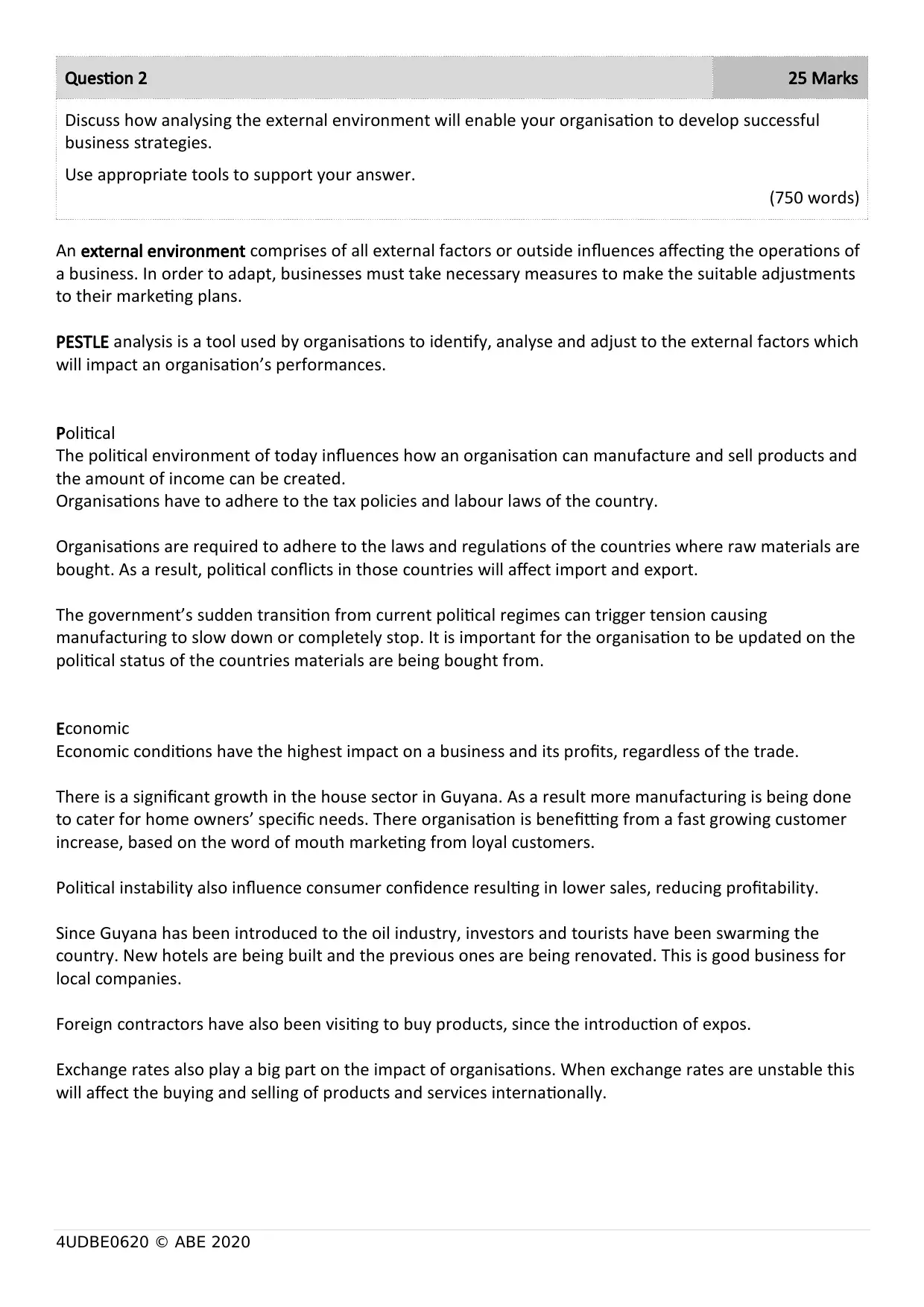
4UDBE0620 © ABE 2020
Question 2 25 Marks
Discuss how analysing the external environment will enable your organisation to develop successful
business strategies.
Use appropriate tools to support your answer.
(750 words)
An external environment comprises of all external factors or outside influences affecting the operations of
a business. In order to adapt, businesses must take necessary measures to make the suitable adjustments
to their marketing plans.
PESTLE analysis is a tool used by organisations to identify, analyse and adjust to the external factors which
will impact an organisation’s performances.
Political
The political environment of today influences how an organisation can manufacture and sell products and
the amount of income can be created.
Organisations have to adhere to the tax policies and labour laws of the country.
Organisations are required to adhere to the laws and regulations of the countries where raw materials are
bought. As a result, political conflicts in those countries will affect import and export.
The government’s sudden transition from current political regimes can trigger tension causing
manufacturing to slow down or completely stop. It is important for the organisation to be updated on the
political status of the countries materials are being bought from.
Economic
Economic conditions have the highest impact on a business and its profits, regardless of the trade.
There is a significant growth in the house sector in Guyana. As a result more manufacturing is being done
to cater for home owners’ specific needs. There organisation is benefitting from a fast growing customer
increase, based on the word of mouth marketing from loyal customers.
Political instability also influence consumer confidence resulting in lower sales, reducing profitability.
Since Guyana has been introduced to the oil industry, investors and tourists have been swarming the
country. New hotels are being built and the previous ones are being renovated. This is good business for
local companies.
Foreign contractors have also been visiting to buy products, since the introduction of expos.
Exchange rates also play a big part on the impact of organisations. When exchange rates are unstable this
will affect the buying and selling of products and services internationally.
Question 2 25 Marks
Discuss how analysing the external environment will enable your organisation to develop successful
business strategies.
Use appropriate tools to support your answer.
(750 words)
An external environment comprises of all external factors or outside influences affecting the operations of
a business. In order to adapt, businesses must take necessary measures to make the suitable adjustments
to their marketing plans.
PESTLE analysis is a tool used by organisations to identify, analyse and adjust to the external factors which
will impact an organisation’s performances.
Political
The political environment of today influences how an organisation can manufacture and sell products and
the amount of income can be created.
Organisations have to adhere to the tax policies and labour laws of the country.
Organisations are required to adhere to the laws and regulations of the countries where raw materials are
bought. As a result, political conflicts in those countries will affect import and export.
The government’s sudden transition from current political regimes can trigger tension causing
manufacturing to slow down or completely stop. It is important for the organisation to be updated on the
political status of the countries materials are being bought from.
Economic
Economic conditions have the highest impact on a business and its profits, regardless of the trade.
There is a significant growth in the house sector in Guyana. As a result more manufacturing is being done
to cater for home owners’ specific needs. There organisation is benefitting from a fast growing customer
increase, based on the word of mouth marketing from loyal customers.
Political instability also influence consumer confidence resulting in lower sales, reducing profitability.
Since Guyana has been introduced to the oil industry, investors and tourists have been swarming the
country. New hotels are being built and the previous ones are being renovated. This is good business for
local companies.
Foreign contractors have also been visiting to buy products, since the introduction of expos.
Exchange rates also play a big part on the impact of organisations. When exchange rates are unstable this
will affect the buying and selling of products and services internationally.
Paraphrase This Document
Need a fresh take? Get an instant paraphrase of this document with our AI Paraphraser
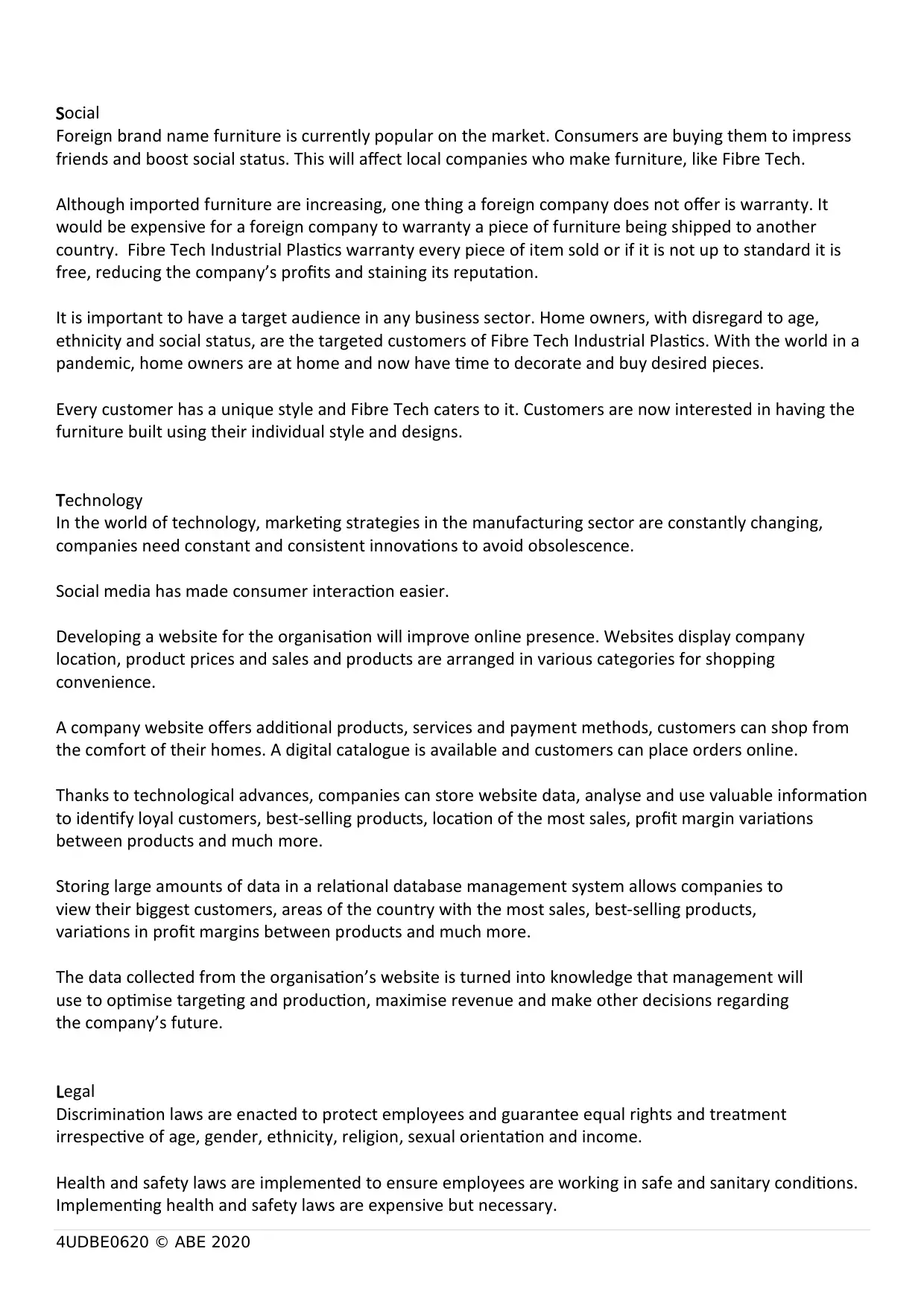
4UDBE0620 © ABE 2020
Social
Foreign brand name furniture is currently popular on the market. Consumers are buying them to impress
friends and boost social status. This will affect local companies who make furniture, like Fibre Tech.
Although imported furniture are increasing, one thing a foreign company does not offer is warranty. It
would be expensive for a foreign company to warranty a piece of furniture being shipped to another
country. Fibre Tech Industrial Plastics warranty every piece of item sold or if it is not up to standard it is
free, reducing the company’s profits and staining its reputation.
It is important to have a target audience in any business sector. Home owners, with disregard to age,
ethnicity and social status, are the targeted customers of Fibre Tech Industrial Plastics. With the world in a
pandemic, home owners are at home and now have time to decorate and buy desired pieces.
Every customer has a unique style and Fibre Tech caters to it. Customers are now interested in having the
furniture built using their individual style and designs.
Technology
In the world of technology, marketing strategies in the manufacturing sector are constantly changing,
companies need constant and consistent innovations to avoid obsolescence.
Social media has made consumer interaction easier.
Developing a website for the organisation will improve online presence. Websites display company
location, product prices and sales and products are arranged in various categories for shopping
convenience.
A company website offers additional products, services and payment methods, customers can shop from
the comfort of their homes. A digital catalogue is available and customers can place orders online.
Thanks to technological advances, companies can store website data, analyse and use valuable information
to identify loyal customers, best-selling products, location of the most sales, profit margin variations
between products and much more.
Storing large amounts of data in a relational database management system allows companies to
view their biggest customers, areas of the country with the most sales, best-selling products,
variations in profit margins between products and much more.
The data collected from the organisation’s website is turned into knowledge that management will
use to optimise targeting and production, maximise revenue and make other decisions regarding
the company’s future.
Legal
Discrimination laws are enacted to protect employees and guarantee equal rights and treatment
irrespective of age, gender, ethnicity, religion, sexual orientation and income.
Health and safety laws are implemented to ensure employees are working in safe and sanitary conditions.
Implementing health and safety laws are expensive but necessary.
Social
Foreign brand name furniture is currently popular on the market. Consumers are buying them to impress
friends and boost social status. This will affect local companies who make furniture, like Fibre Tech.
Although imported furniture are increasing, one thing a foreign company does not offer is warranty. It
would be expensive for a foreign company to warranty a piece of furniture being shipped to another
country. Fibre Tech Industrial Plastics warranty every piece of item sold or if it is not up to standard it is
free, reducing the company’s profits and staining its reputation.
It is important to have a target audience in any business sector. Home owners, with disregard to age,
ethnicity and social status, are the targeted customers of Fibre Tech Industrial Plastics. With the world in a
pandemic, home owners are at home and now have time to decorate and buy desired pieces.
Every customer has a unique style and Fibre Tech caters to it. Customers are now interested in having the
furniture built using their individual style and designs.
Technology
In the world of technology, marketing strategies in the manufacturing sector are constantly changing,
companies need constant and consistent innovations to avoid obsolescence.
Social media has made consumer interaction easier.
Developing a website for the organisation will improve online presence. Websites display company
location, product prices and sales and products are arranged in various categories for shopping
convenience.
A company website offers additional products, services and payment methods, customers can shop from
the comfort of their homes. A digital catalogue is available and customers can place orders online.
Thanks to technological advances, companies can store website data, analyse and use valuable information
to identify loyal customers, best-selling products, location of the most sales, profit margin variations
between products and much more.
Storing large amounts of data in a relational database management system allows companies to
view their biggest customers, areas of the country with the most sales, best-selling products,
variations in profit margins between products and much more.
The data collected from the organisation’s website is turned into knowledge that management will
use to optimise targeting and production, maximise revenue and make other decisions regarding
the company’s future.
Legal
Discrimination laws are enacted to protect employees and guarantee equal rights and treatment
irrespective of age, gender, ethnicity, religion, sexual orientation and income.
Health and safety laws are implemented to ensure employees are working in safe and sanitary conditions.
Implementing health and safety laws are expensive but necessary.
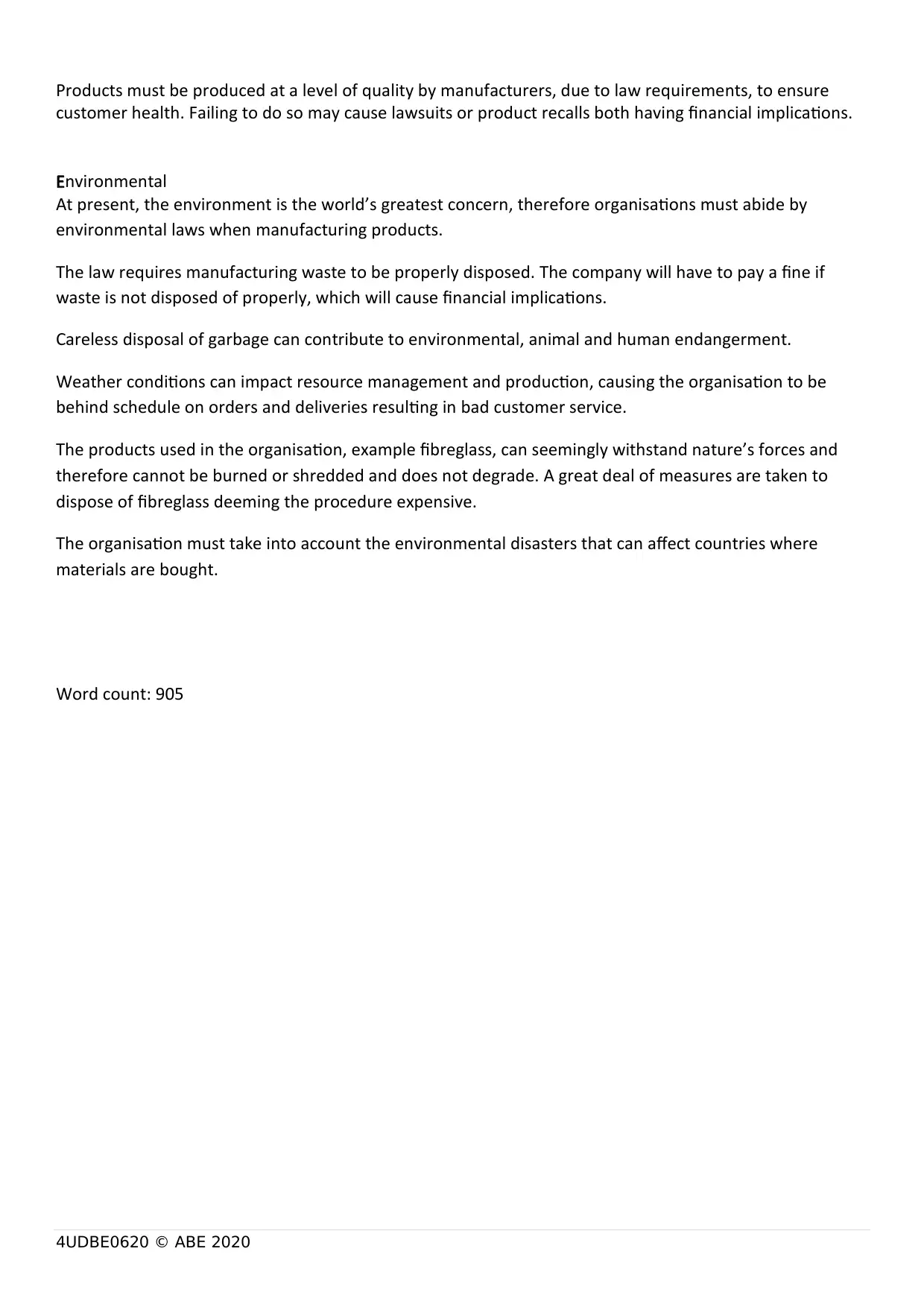
4UDBE0620 © ABE 2020
Products must be produced at a level of quality by manufacturers, due to law requirements, to ensure
customer health. Failing to do so may cause lawsuits or product recalls both having financial implications.
Environmental
At present, the environment is the world’s greatest concern, therefore organisations must abide by
environmental laws when manufacturing products.
The law requires manufacturing waste to be properly disposed. The company will have to pay a fine if
waste is not disposed of properly, which will cause financial implications.
Careless disposal of garbage can contribute to environmental, animal and human endangerment.
Weather conditions can impact resource management and production, causing the organisation to be
behind schedule on orders and deliveries resulting in bad customer service.
The products used in the organisation, example fibreglass, can seemingly withstand nature’s forces and
therefore cannot be burned or shredded and does not degrade. A great deal of measures are taken to
dispose of fibreglass deeming the procedure expensive.
The organisation must take into account the environmental disasters that can affect countries where
materials are bought.
Word count: 905
Products must be produced at a level of quality by manufacturers, due to law requirements, to ensure
customer health. Failing to do so may cause lawsuits or product recalls both having financial implications.
Environmental
At present, the environment is the world’s greatest concern, therefore organisations must abide by
environmental laws when manufacturing products.
The law requires manufacturing waste to be properly disposed. The company will have to pay a fine if
waste is not disposed of properly, which will cause financial implications.
Careless disposal of garbage can contribute to environmental, animal and human endangerment.
Weather conditions can impact resource management and production, causing the organisation to be
behind schedule on orders and deliveries resulting in bad customer service.
The products used in the organisation, example fibreglass, can seemingly withstand nature’s forces and
therefore cannot be burned or shredded and does not degrade. A great deal of measures are taken to
dispose of fibreglass deeming the procedure expensive.
The organisation must take into account the environmental disasters that can affect countries where
materials are bought.
Word count: 905
⊘ This is a preview!⊘
Do you want full access?
Subscribe today to unlock all pages.

Trusted by 1+ million students worldwide
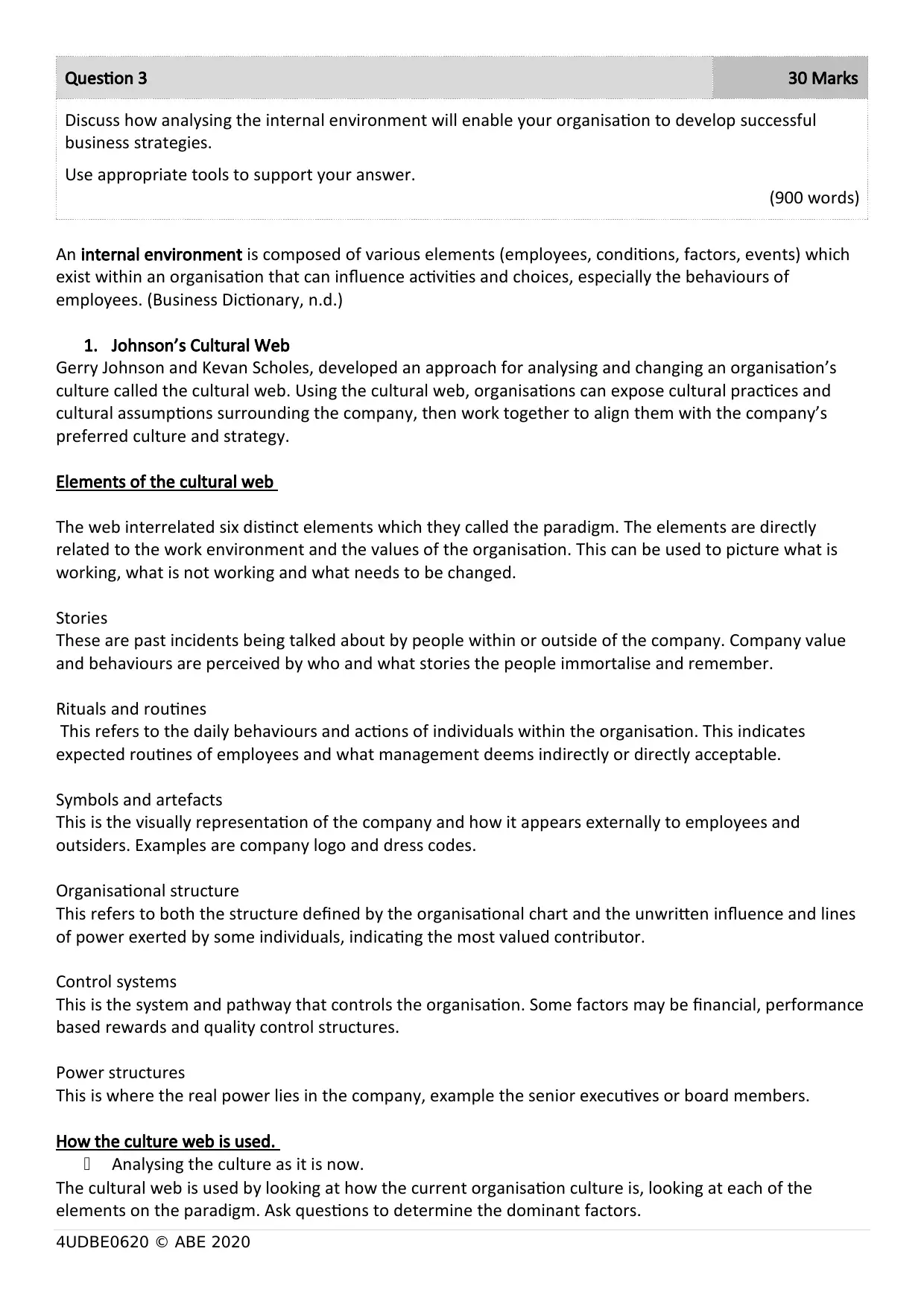
4UDBE0620 © ABE 2020
Question 3 30 Marks
Discuss how analysing the internal environment will enable your organisation to develop successful
business strategies.
Use appropriate tools to support your answer.
(900 words)
An internal environment is composed of various elements (employees, conditions, factors, events) which
exist within an organisation that can influence activities and choices, especially the behaviours of
employees. (Business Dictionary, n.d.)
1. Johnson’s Cultural Web
Gerry Johnson and Kevan Scholes, developed an approach for analysing and changing an organisation’s
culture called the cultural web. Using the cultural web, organisations can expose cultural practices and
cultural assumptions surrounding the company, then work together to align them with the company’s
preferred culture and strategy.
Elements of the cultural web
The web interrelated six distinct elements which they called the paradigm. The elements are directly
related to the work environment and the values of the organisation. This can be used to picture what is
working, what is not working and what needs to be changed.
Stories
These are past incidents being talked about by people within or outside of the company. Company value
and behaviours are perceived by who and what stories the people immortalise and remember.
Rituals and routines
This refers to the daily behaviours and actions of individuals within the organisation. This indicates
expected routines of employees and what management deems indirectly or directly acceptable.
Symbols and artefacts
This is the visually representation of the company and how it appears externally to employees and
outsiders. Examples are company logo and dress codes.
Organisational structure
This refers to both the structure defined by the organisational chart and the unwritten influence and lines
of power exerted by some individuals, indicating the most valued contributor.
Control systems
This is the system and pathway that controls the organisation. Some factors may be financial, performance
based rewards and quality control structures.
Power structures
This is where the real power lies in the company, example the senior executives or board members.
How the culture web is used.
Analysing the culture as it is now.
The cultural web is used by looking at how the current organisation culture is, looking at each of the
elements on the paradigm. Ask questions to determine the dominant factors.
Question 3 30 Marks
Discuss how analysing the internal environment will enable your organisation to develop successful
business strategies.
Use appropriate tools to support your answer.
(900 words)
An internal environment is composed of various elements (employees, conditions, factors, events) which
exist within an organisation that can influence activities and choices, especially the behaviours of
employees. (Business Dictionary, n.d.)
1. Johnson’s Cultural Web
Gerry Johnson and Kevan Scholes, developed an approach for analysing and changing an organisation’s
culture called the cultural web. Using the cultural web, organisations can expose cultural practices and
cultural assumptions surrounding the company, then work together to align them with the company’s
preferred culture and strategy.
Elements of the cultural web
The web interrelated six distinct elements which they called the paradigm. The elements are directly
related to the work environment and the values of the organisation. This can be used to picture what is
working, what is not working and what needs to be changed.
Stories
These are past incidents being talked about by people within or outside of the company. Company value
and behaviours are perceived by who and what stories the people immortalise and remember.
Rituals and routines
This refers to the daily behaviours and actions of individuals within the organisation. This indicates
expected routines of employees and what management deems indirectly or directly acceptable.
Symbols and artefacts
This is the visually representation of the company and how it appears externally to employees and
outsiders. Examples are company logo and dress codes.
Organisational structure
This refers to both the structure defined by the organisational chart and the unwritten influence and lines
of power exerted by some individuals, indicating the most valued contributor.
Control systems
This is the system and pathway that controls the organisation. Some factors may be financial, performance
based rewards and quality control structures.
Power structures
This is where the real power lies in the company, example the senior executives or board members.
How the culture web is used.
Analysing the culture as it is now.
The cultural web is used by looking at how the current organisation culture is, looking at each of the
elements on the paradigm. Ask questions to determine the dominant factors.
Paraphrase This Document
Need a fresh take? Get an instant paraphrase of this document with our AI Paraphraser
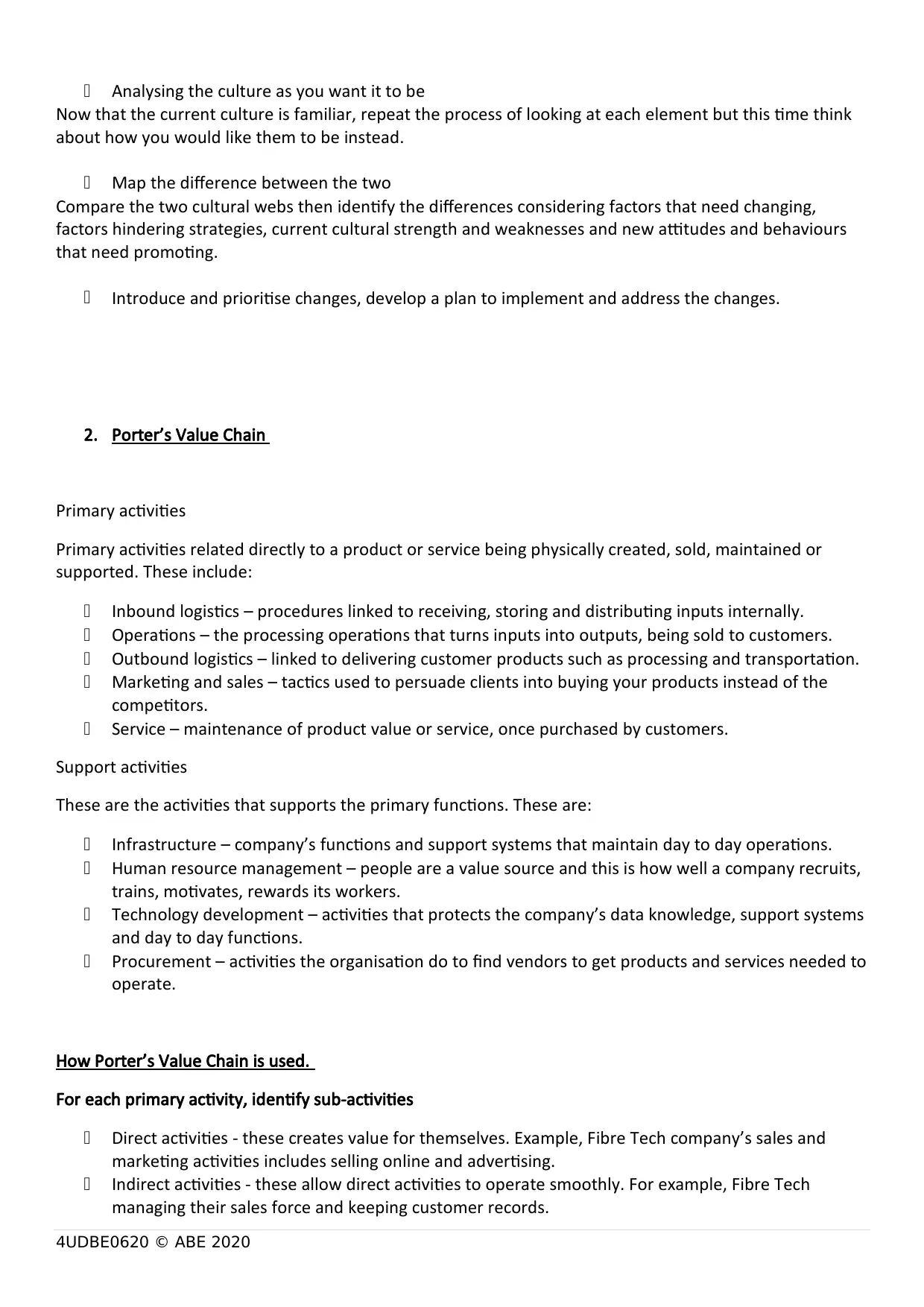
4UDBE0620 © ABE 2020
Analysing the culture as you want it to be
Now that the current culture is familiar, repeat the process of looking at each element but this time think
about how you would like them to be instead.
Map the difference between the two
Compare the two cultural webs then identify the differences considering factors that need changing,
factors hindering strategies, current cultural strength and weaknesses and new attitudes and behaviours
that need promoting.
Introduce and prioritise changes, develop a plan to implement and address the changes.
2. Porter’s Value Chain
Primary activities
Primary activities related directly to a product or service being physically created, sold, maintained or
supported. These include:
Inbound logistics – procedures linked to receiving, storing and distributing inputs internally.
Operations – the processing operations that turns inputs into outputs, being sold to customers.
Outbound logistics – linked to delivering customer products such as processing and transportation.
Marketing and sales – tactics used to persuade clients into buying your products instead of the
competitors.
Service – maintenance of product value or service, once purchased by customers.
Support activities
These are the activities that supports the primary functions. These are:
Infrastructure – company’s functions and support systems that maintain day to day operations.
Human resource management – people are a value source and this is how well a company recruits,
trains, motivates, rewards its workers.
Technology development – activities that protects the company’s data knowledge, support systems
and day to day functions.
Procurement – activities the organisation do to find vendors to get products and services needed to
operate.
How Porter’s Value Chain is used.
For each primary activity, identify sub-activities
Direct activities - these creates value for themselves. Example, Fibre Tech company’s sales and
marketing activities includes selling online and advertising.
Indirect activities - these allow direct activities to operate smoothly. For example, Fibre Tech
managing their sales force and keeping customer records.
Analysing the culture as you want it to be
Now that the current culture is familiar, repeat the process of looking at each element but this time think
about how you would like them to be instead.
Map the difference between the two
Compare the two cultural webs then identify the differences considering factors that need changing,
factors hindering strategies, current cultural strength and weaknesses and new attitudes and behaviours
that need promoting.
Introduce and prioritise changes, develop a plan to implement and address the changes.
2. Porter’s Value Chain
Primary activities
Primary activities related directly to a product or service being physically created, sold, maintained or
supported. These include:
Inbound logistics – procedures linked to receiving, storing and distributing inputs internally.
Operations – the processing operations that turns inputs into outputs, being sold to customers.
Outbound logistics – linked to delivering customer products such as processing and transportation.
Marketing and sales – tactics used to persuade clients into buying your products instead of the
competitors.
Service – maintenance of product value or service, once purchased by customers.
Support activities
These are the activities that supports the primary functions. These are:
Infrastructure – company’s functions and support systems that maintain day to day operations.
Human resource management – people are a value source and this is how well a company recruits,
trains, motivates, rewards its workers.
Technology development – activities that protects the company’s data knowledge, support systems
and day to day functions.
Procurement – activities the organisation do to find vendors to get products and services needed to
operate.
How Porter’s Value Chain is used.
For each primary activity, identify sub-activities
Direct activities - these creates value for themselves. Example, Fibre Tech company’s sales and
marketing activities includes selling online and advertising.
Indirect activities - these allow direct activities to operate smoothly. For example, Fibre Tech
managing their sales force and keeping customer records.
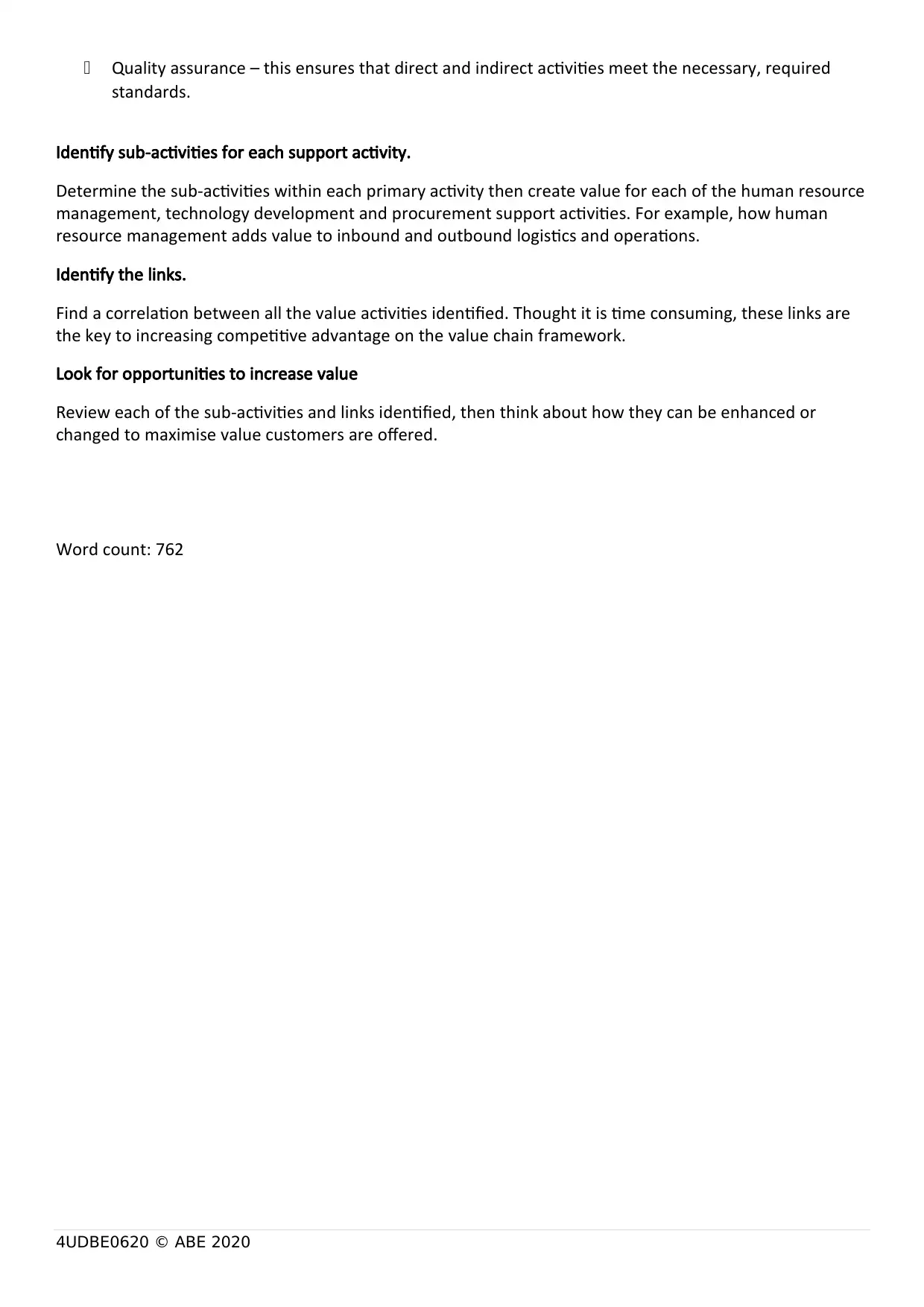
4UDBE0620 © ABE 2020
Quality assurance – this ensures that direct and indirect activities meet the necessary, required
standards.
Identify sub-activities for each support activity.
Determine the sub-activities within each primary activity then create value for each of the human resource
management, technology development and procurement support activities. For example, how human
resource management adds value to inbound and outbound logistics and operations.
Identify the links.
Find a correlation between all the value activities identified. Thought it is time consuming, these links are
the key to increasing competitive advantage on the value chain framework.
Look for opportunities to increase value
Review each of the sub-activities and links identified, then think about how they can be enhanced or
changed to maximise value customers are offered.
Word count: 762
Quality assurance – this ensures that direct and indirect activities meet the necessary, required
standards.
Identify sub-activities for each support activity.
Determine the sub-activities within each primary activity then create value for each of the human resource
management, technology development and procurement support activities. For example, how human
resource management adds value to inbound and outbound logistics and operations.
Identify the links.
Find a correlation between all the value activities identified. Thought it is time consuming, these links are
the key to increasing competitive advantage on the value chain framework.
Look for opportunities to increase value
Review each of the sub-activities and links identified, then think about how they can be enhanced or
changed to maximise value customers are offered.
Word count: 762
⊘ This is a preview!⊘
Do you want full access?
Subscribe today to unlock all pages.

Trusted by 1+ million students worldwide
1 out of 19
Related Documents
Your All-in-One AI-Powered Toolkit for Academic Success.
+13062052269
info@desklib.com
Available 24*7 on WhatsApp / Email
![[object Object]](/_next/static/media/star-bottom.7253800d.svg)
Unlock your academic potential
Copyright © 2020–2025 A2Z Services. All Rights Reserved. Developed and managed by ZUCOL.





